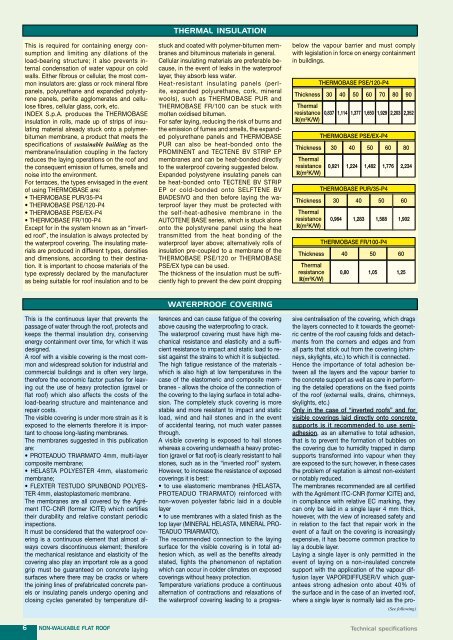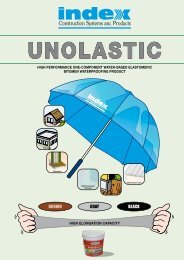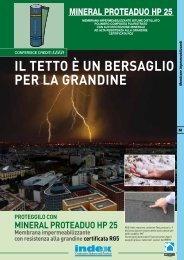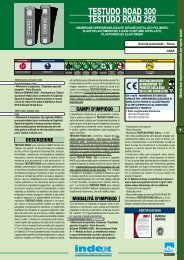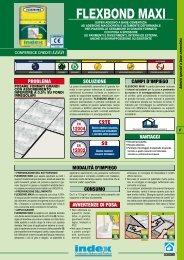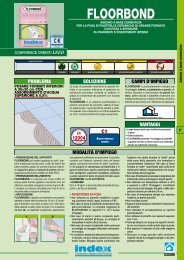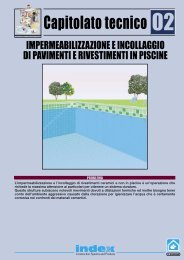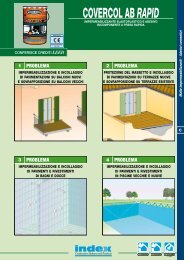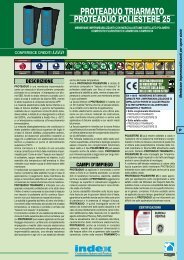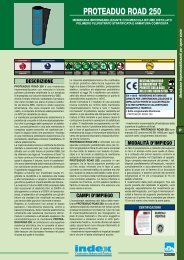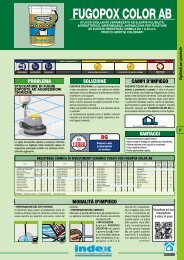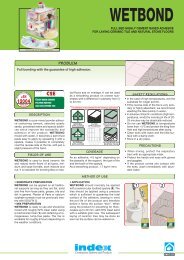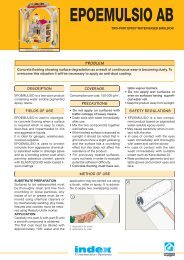Technical specification - Index S.p.A.
Technical specification - Index S.p.A.
Technical specification - Index S.p.A.
Create successful ePaper yourself
Turn your PDF publications into a flip-book with our unique Google optimized e-Paper software.
This is required for containing energy consumption<br />
and limiting any dilations of the<br />
load-bearing structure; it also prevents internal<br />
condensation of water vapour on cold<br />
walls. Either fibrous or cellular, the most common<br />
insulators are: glass or rock mineral fibre<br />
panels, polyurethane and expanded polystyrene<br />
panels, perlite agglomerates and cellulose<br />
fibres, cellular glass, cork, etc.<br />
INDEX S.p.A. produces the THERMOBASE<br />
insulation in rolls, made up of strips of insulating<br />
material already stuck onto a polymerbitumen<br />
membrane, a product that meets the<br />
<strong>specification</strong>s of sustainable building as the<br />
membrane/insulation coupling in the factory<br />
reduces the laying operations on the roof and<br />
the consequent emission of fumes, smells and<br />
noise into the environment.<br />
For terraces, the types envisaged in the event<br />
of using THERMOBASE are:<br />
• THERMOBASE PUR/35-P4<br />
• THERMOBASE PSE/120-P4<br />
• THERMOBASE PSE/EX-P4<br />
• THERMOBASE FR/100-P4<br />
Except for in the system known as an “inverted<br />
roof”, the insulation is always protected by<br />
the waterproof covering. The insulating materials<br />
are produced in different types, densities<br />
and dimensions, according to their destination.<br />
It is important to choose materials of the<br />
type expressly declared by the manufacturer<br />
as being suitable for roof insulation and to be<br />
This is the continuous layer that prevents the<br />
passage of water through the roof, protects and<br />
keeps the thermal insulation dry, conserving<br />
energy containment over time, for which it was<br />
designed.<br />
A roof with a visible covering is the most common<br />
and widespread solution for industrial and<br />
commercial buildings and is often very large,<br />
therefore the economic factor pushes for leaving<br />
out the use of heavy protection (gravel or<br />
flat roof) which also affects the costs of the<br />
load-bearing structure and maintenance and<br />
repair costs.<br />
The visible covering is under more strain as it is<br />
exposed to the elements therefore it is important<br />
to choose long-lasting membranes.<br />
The membranes suggested in this publication<br />
are:<br />
• PROTEADUO TRIARMATO 4mm, multi-layer<br />
composite membrane;<br />
• HELASTA POLYESTER 4mm, elastomeric<br />
membrane;<br />
• FLEXTER TESTUDO SPUNBOND POLYES-<br />
TER 4mm, elastoplastomeric membrane.<br />
The membranes are all covered by the Agrément<br />
ITC-CNR (former ICITE) which certifies<br />
their durability and relative constant periodic<br />
inspections.<br />
It must be considered that the waterproof covering<br />
is a continuous element that almost always<br />
covers discontinuous element; therefore<br />
the mechanical resistance and elasticity of the<br />
covering also play an important role as a good<br />
grip must be guaranteed on concrete laying<br />
surfaces where there may be cracks or where<br />
the joining lines of prefabricated concrete panels<br />
or insulating panels undergo opening and<br />
closing cycles generated by temperature dif-<br />
THERMAL INSULATION<br />
stuck and coated with polymer-bitumen membranes<br />
and bituminous materials in general.<br />
Cellular insulating materials are preferable because,<br />
in the event of leaks in the waterproof<br />
layer, they absorb less water.<br />
Heat-resistant insulating panels (perlite,<br />
expanded polyurethane, cork, mineral<br />
wools), such as THERMOBASE PUR and<br />
THERMOBASE FR/100 can be stuck with<br />
molten oxidised bitumen.<br />
For safer laying, reducing the risk of burns and<br />
the emission of fumes and smells, the expanded<br />
polyurethane panels and THERMOBASE<br />
PUR can also be heat-bonded onto the<br />
PROMINENT and TECTENE BV STRIP EP<br />
membranes and can be heat-bonded directly<br />
to the waterproof covering suggested below.<br />
Expanded polystyrene insulating panels can<br />
be heat-bonded onto TECTENE BV STRIP<br />
EP or cold-bonded onto SELFTENE BV<br />
BIADESIVO and then before laying the waterproof<br />
layer they must be protected with<br />
the self-heat-adhesive membrane in the<br />
AUTOTENE BASE series, which is stuck alone<br />
onto the polystyrene panel using the heat<br />
transmitted from the heat bonding of the<br />
waterproof layer above; alternatively rolls of<br />
insulation pre-coupled to a membrane of the<br />
THERMOBASE PSE/120 or THERMOBASE<br />
PSE/EX type can be used.<br />
The thickness of the insulation must be sufficiently<br />
high to prevent the dew point dropping<br />
WATERPROOF COVERING<br />
ferences and can cause fatigue of the covering<br />
above causing the waterproofing to crack.<br />
The waterproof covering must have high mechanical<br />
resistance and elasticity and a sufficient<br />
resistance to impact and static load to resist<br />
against the strains to which it is subjected.<br />
The high fatigue resistance of the materials -<br />
which is also high at low temperatures in the<br />
case of the elastomeric and composite membranes<br />
- allows the choice of the connection of<br />
the covering to the laying surface in total adhesion.<br />
The completely stuck covering is more<br />
stable and more resistant to impact and static<br />
load, wind and hail stones and in the event<br />
of accidental tearing, not much water passes<br />
through.<br />
A visible covering is exposed to hail stones<br />
whereas a covering underneath a heavy protection<br />
(gravel or flat roof) is clearly resistant to hail<br />
stones, such as in the “inverted roof” system.<br />
However, to increase the resistance of exposed<br />
coverings it is best:<br />
• to use elastomeric membranes (HELASTA,<br />
PROTEADUO TRIARMATO) reinforced with<br />
non-woven polyester fabric laid in a double<br />
layer<br />
• to use membranes with a slated finish as the<br />
top layer (MINERAL HELASTA, MINERAL PRO-<br />
TEADUO TRIARMATO).<br />
The recommended connection to the laying<br />
surface for the visible covering is in total adhesion<br />
which, as well as the benefits already<br />
stated, fights the phenomenon of reptation<br />
which can occur in colder climates on exposed<br />
coverings without heavy protection.<br />
Temperature variations produce a continuous<br />
alternation of contractions and relaxations of<br />
the waterproof covering leading to a progres-<br />
below the vapour barrier and must comply<br />
with legislation in force on energy containment<br />
in buildings.<br />
Thickness 30 40 50 60 70<br />
Thermal<br />
resistance<br />
R(m 2 K/W)<br />
Thickness<br />
Thermal<br />
resistance<br />
R(m 2 K/W)<br />
Thickness<br />
Thermal<br />
resistance<br />
R(m 2 K/W)<br />
Thickness<br />
Thermal<br />
resistance<br />
R(m 2 K/W)<br />
THERMOBASE PSE/120-P4<br />
0,837 1,114 1,377 1,650 1,929 2,203 2,352<br />
THERMOBASE PSE/EX-P4<br />
30 40<br />
0,921 1,224<br />
THERMOBASE PUR/35-P4<br />
6 NON-WALKABLE FLAT ROOF <strong>Technical</strong> <strong>specification</strong>s<br />
30<br />
0,964<br />
40<br />
0,80<br />
40<br />
1,283<br />
50<br />
1,482<br />
50<br />
1,588<br />
THERMOBASE FR/100-P4<br />
60<br />
1,776<br />
80<br />
2,234<br />
60<br />
1,902<br />
sive centralisation of the covering, which drags<br />
the layers connected to it towards the geometric<br />
centre of the roof causing folds and detachments<br />
from the corners and edges and from<br />
all parts that stick out from the covering (chimneys,<br />
skylights, etc.) to which it is connected.<br />
Hence the importance of total adhesion between<br />
all the layers and the vapour barrier to<br />
the concrete support as well as care in performing<br />
the detailed operations on the fixed points<br />
of the roof (external walls, drains, chimneys,<br />
skylights, etc.)<br />
Only in the case of “inverted roofs” and for<br />
visible coverings laid directly onto concrete<br />
supports is it recommended to use semiadhesion,<br />
as an alternative to total adhesion,<br />
that is to prevent the formation of bubbles on<br />
the covering due to humidity trapped in damp<br />
supports transformed into vapour when they<br />
are exposed to the sun; however, in these cases<br />
the problem of reptation is almost non-existent<br />
or notably reduced.<br />
The membranes recommended are all certified<br />
with the Agrément ITC-CNR (former ICITE) and,<br />
in compliance with relative EC marking, they<br />
can only be laid in a single layer 4 mm thick,<br />
however, with the view of increased safety and<br />
in relation to the fact that repair work in the<br />
event of a fault on the covering is increasingly<br />
expensive, it has become common practice to<br />
lay a double layer.<br />
Laying a single layer is only permitted in the<br />
event of laying on a non-insulated concrete<br />
support with the application of the vapour diffusion<br />
layer VAPORDIFFUSER/V which guarantees<br />
strong adhesion onto about 40% of<br />
the surface and in the case of an inverted roof,<br />
where a single layer is normally laid as the pro-<br />
50<br />
1,05<br />
80<br />
60<br />
1,25<br />
90<br />
(See following)


